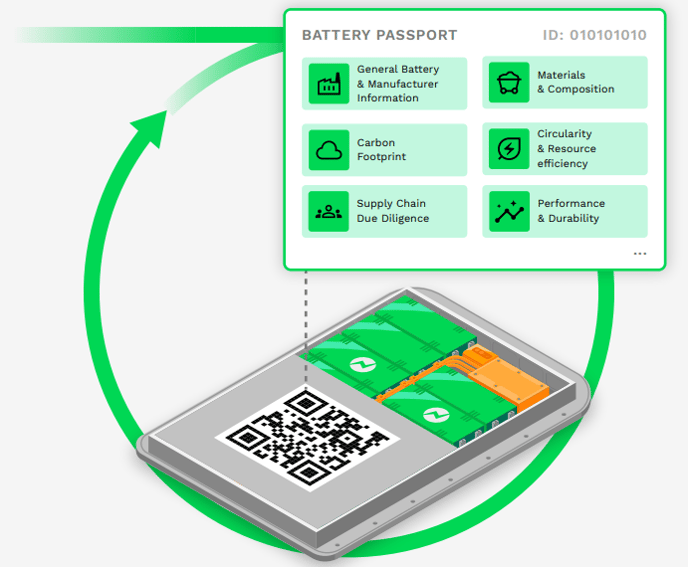The Battery Passport is a digital document mandated by the European Union to enhance the sustainability, transparency, and circularity of batteries. This initiative aims to support the EU’s goals of reducing environmental impact and promoting a circular economy within the battery industry.
Here are the key actions defined by the EU regarding the Battery Passport:
- Tracking and Transparency: The Battery Passport provides detailed information about the entire lifecycle of a battery, from raw material extraction to manufacturing, usage, and recycling. This ensures transparency and accountability in the supply chain.
- Sustainability and Compliance: The passport helps ensure that batteries meet specific environmental and ethical standards set by the EU, such as responsible sourcing of raw materials and adherence to labor laws.
- CO2 Emission Reporting: The Battery Passport includes data on the carbon footprint associated with the production, usage, and recycling of the battery. This information is crucial for monitoring and reducing CO2 emissions in line with the EU’s climate targets.
- Enhanced Recycling and Reuse: By documenting the materials and components used in batteries, the Battery Passport facilitates efficient recycling and reuse, contributing to a more circular economy.
- Consumer Information: The passport provides end-users with essential information about the battery's origin, performance, and environmental impact, helping consumers make informed decisions.
- Regulatory Compliance: The initiative supports manufacturers and suppliers in complying with EU regulations and standards, fostering a more sustainable and responsible battery industry.
All batteries must feature a QR code for ongoing access to their passports. This QR code should be updated whenever changes occur to the battery or its use in the value chain. The QR code will connect to an online system containing publicly accessible information about the battery's performance, durability, and health status.
Picture source: Battery Passport Content Requirements, p. 1
Driving Sustainable Practices and Reducing CO2 Emissions in Alignment with the European Green Deal
The Battery Passport aligns closely with the objectives of the European Green Deal, which aims to transform the EU into a modern, resource-efficient, and competitive economy with no net emissions of greenhouse gases by 2050.
Here’s how it fits in and impacts CO2 emissions:
1. Sustainable Product Lifecycle
The Battery Passport ensures batteries are produced, used, and disposed of sustainably, supporting the Green Deal's goals for sustainable production and consumption.
2. Reduction of CO2 Emissions
- Tracking Carbon Footprint: It includes data on CO2 emissions for each stage of the battery's lifecycle, enabling better monitoring and reduction of greenhouse gases.
- Encouraging Low-Carbon Technologies: Makes carbon footprints transparent, incentivising cleaner production methods.
3. Circular Economy
- Facilitating Recycling and Reuse: Documents materials and components, promoting efficient recycling and reducing waste.
- Reducing Raw Material Dependency: Promotes recycling, decreasing the need for new raw materials and minimising environmental impact.
4. Resource Efficiency
- Efficient Use of Resources: Provides detailed records of materials used, encouraging resource efficiency.
- Sustainable Sourcing: Ensures materials are sourced sustainably and ethically.
5. Boosting Innovation
- Driving Technological Advances: Encourages development of sustainable technologies that meet high transparency and sustainability standards.
- Promoting Competitive Markets: Creates a level playing field for innovative, sustainable products.
in conclusion, the EU Battery Passport supports the European Green Deal by enhancing transparency, promoting sustainability, reducing CO2 emissions, and encouraging a circular economy, thereby advancing the EU’s environmental and economic goals.
Sustainable Battery Law Timeline
|
1. Carbon Footprint declaration requirements: |
![]()
| 2. Carbon footprint performance class labels:
From July 1, 2025 (EP) and Jan 1, 2026 (EC) |
![]()
|
3. Ban on the worst-performing batteries: |
![]()
|
4. Digital battery passport for batteries: From February 18, 2027 for global value chain |
Cotes Ultradry
Cotes Ultradry offers energy-efficient dry-air solutions for battery dry rooms, achieving ultralow dew points from -40°C to -120°C. These solutions not only reduce energy consumption but also enable the utilisation of renewable energy sources, leading to a significant decrease in carbon emissions. Given the growing focus on reducing CO2 emissions, we believe this approach will become a unique selling proposition in battery manufacturing. Choosing The Right Way To Dry aligns with our commitment to sustainability and ensures a greener future for the industry. Read more: COTES EXERGIC TECHNOLOGY®
[1] Source: MEPs want to strengthen new EU rules for design, production and disposal of batteries
[2] Source: The Value of the EU Battery Passport
[3] Source: Waste and Recycling - Batteries
[4] Source: The European Green Deal
[5] Source: Circular economy: New law on more sustainable, circular and safe batteries enters into force

